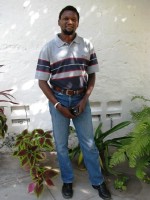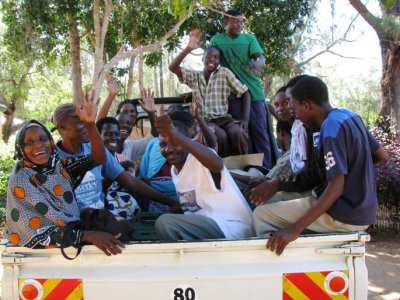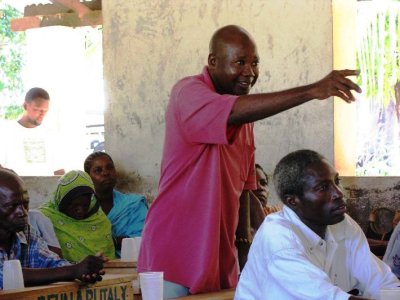You might have been wondering why there has not been news. I have had to put work aside for a week to attend to some critical, urgent personal matter, in fact to pay dowry for my wife to be on the 11th of October. You never know what to expect in this and therefore leaving very little room to prepare ending up very supprised by what it turns out to be. Caro (Caroline) my fiance comes from the Kamba tribe so we travelled about 800 km north to Tala where she comes from, a beautiful country side about 60 km from Nairobi. My mother was very supprised to learn that coffee is from berries and not leaves of the coffee plant. Having spent all her time down at the coast, she was indeed thrilled by the long journey and the sudden very different set-up inland.
Among the things required as dowry are 42 live goats, one bull and loads of honey. Most interesting, I dont't do alot of slaughtering at home but here, I have had to slaughter a goat as a symbol of accepting Caro. This went very well and the meat was delicous. After all the feasting we were alowed to negotiate on the dowry and give a date for when we shall present this price. 6th of September was agreed at in the end; barely one month before the wedding.
I am looking forward to the 12 hrs drive tomorrow night going back to work!







 My names are Tony Kanundu alias Bats; I work for ASSETS as a Community Conservation Officer. I grew up at Gede 500m from the edge of the Arabuko-Sokoke Forest. I am named Kanundu after my grandfather who was really a character of his kind. Locally, the name has two meanings. In Swahili language, Kanundu is a small hump of any animal and in Giriama, my first language, Kanundu is a bat; the flying mammal. Guess which character I am! My grandfathers’ characters resembled those of a bat but he could neither fly nor was he nocturnal. He was known to be tricky and a strategist and he could do things many people didn’t believe. He could disperse a crowd helter-skelter with his own intention, the same way Drogba can cut through a solid defense call it of any soccer team. When I was taught about mammals in high school, I was very amazed to learn the real character of the real flying mammal. As my grandpa could do, a bat which is nocturnal moves in a very marvelous way, without eyes it uses echo-location. As it flies lazily, it sends rays ahead and if there are any obstacles, the rays are reflected back to it and the Bat changes its route and it is able to enjoy its world in the night. As I grew at age 14 I joined a local football club, Clarkes Weaver which was supported by Kenya Wildlife Service, Gede Forest station. The playing field was right in the forest and this was an opportunity to see wild animals. Apart from playing football I was voluntarily involved in small forest conservation activities. During and after high school I was very active member of the football club and later through my local church I joined A Rocha Kenya as a volunteer in the ASSETS programme. After 14 months volunteering, I had significant know how on the environment and the community around and the need for its involvement in conservation of the natural resources. This was a good time for me to move on. I stopped volunteering and joined Kenya Wildlife Service Training Institute where I studied Environmental Management for 2 years. Early January 2007, a few weeks before I graduated, I was called up by the ASSETS Co-ordinator to take up this job in the Community project. Ever since, I am enjoying working with the communities for the environment from the environment.
My names are Tony Kanundu alias Bats; I work for ASSETS as a Community Conservation Officer. I grew up at Gede 500m from the edge of the Arabuko-Sokoke Forest. I am named Kanundu after my grandfather who was really a character of his kind. Locally, the name has two meanings. In Swahili language, Kanundu is a small hump of any animal and in Giriama, my first language, Kanundu is a bat; the flying mammal. Guess which character I am! My grandfathers’ characters resembled those of a bat but he could neither fly nor was he nocturnal. He was known to be tricky and a strategist and he could do things many people didn’t believe. He could disperse a crowd helter-skelter with his own intention, the same way Drogba can cut through a solid defense call it of any soccer team. When I was taught about mammals in high school, I was very amazed to learn the real character of the real flying mammal. As my grandpa could do, a bat which is nocturnal moves in a very marvelous way, without eyes it uses echo-location. As it flies lazily, it sends rays ahead and if there are any obstacles, the rays are reflected back to it and the Bat changes its route and it is able to enjoy its world in the night. As I grew at age 14 I joined a local football club, Clarkes Weaver which was supported by Kenya Wildlife Service, Gede Forest station. The playing field was right in the forest and this was an opportunity to see wild animals. Apart from playing football I was voluntarily involved in small forest conservation activities. During and after high school I was very active member of the football club and later through my local church I joined A Rocha Kenya as a volunteer in the ASSETS programme. After 14 months volunteering, I had significant know how on the environment and the community around and the need for its involvement in conservation of the natural resources. This was a good time for me to move on. I stopped volunteering and joined Kenya Wildlife Service Training Institute where I studied Environmental Management for 2 years. Early January 2007, a few weeks before I graduated, I was called up by the ASSETS Co-ordinator to take up this job in the Community project. Ever since, I am enjoying working with the communities for the environment from the environment. Today was a day of it's own kind. After a great feasting last evening, saying goodbye to the A Rocha International Managing Director who has been with us for just under a week, half the team arrived late this morning. 9.00 a.m. was the appointed time for us to leave for Mida primary school where we were meeting the parents and students benefiting from the ASSETS bursary fund but it wasn't until 9.30 a.m that we managed to push start the truck whose battery is broken. We had to repeat this exercise twice; 1st when we stopped to fuel the trukc and again when it stalled just a kilometer from the gas station.At last, Tsofa and Tony had to hitch-hike a lift to get to the meeting before the parents gave up waiting and leave. 11.15 a.m is when the meeting started, with 14 students and 21 parents attending.
Today was a day of it's own kind. After a great feasting last evening, saying goodbye to the A Rocha International Managing Director who has been with us for just under a week, half the team arrived late this morning. 9.00 a.m. was the appointed time for us to leave for Mida primary school where we were meeting the parents and students benefiting from the ASSETS bursary fund but it wasn't until 9.30 a.m that we managed to push start the truck whose battery is broken. We had to repeat this exercise twice; 1st when we stopped to fuel the trukc and again when it stalled just a kilometer from the gas station.At last, Tsofa and Tony had to hitch-hike a lift to get to the meeting before the parents gave up waiting and leave. 11.15 a.m is when the meeting started, with 14 students and 21 parents attending.









